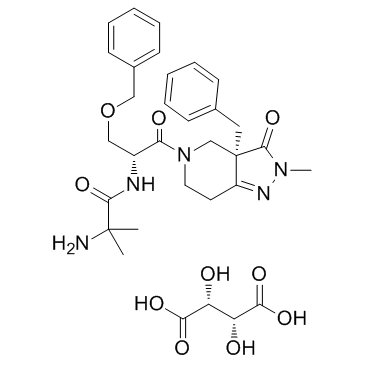Capromorelin tartrate

Capromorelin tartrate structure
|
Common Name | Capromorelin tartrate | ||
|---|---|---|---|---|
| CAS Number | 193273-69-7 | Molecular Weight | 655.70 | |
| Density | N/A | Boiling Point | N/A | |
| Molecular Formula | C32H41N5O10 | Melting Point | N/A | |
| MSDS | Chinese USA | Flash Point | N/A | |
| Symbol |

GHS07 |
Signal Word | Warning | |
Use of Capromorelin tartrateCapromorelin Tartrate is an orally active, potent growth hormone secretagogue receptor (GHSR) agonist, with Ki of 7 nM for hGHS-R1a. |
| Name | (2R,3R)-2,3-Dihydroxysuccinic acid-N-{2-[(3aS)-3a-benzyl-2-meth yl-3-methylene-2,3,3a,4,6,7-hexahydro-5H-pyrazolo[4,3-c]pyridin-5 -yl]-1-(benzyloxy)-2-oxoethyl}-2-methylalaninamide (1:1) |
|---|---|
| Synonym | More Synonyms |
| Description | Capromorelin Tartrate is an orally active, potent growth hormone secretagogue receptor (GHSR) agonist, with Ki of 7 nM for hGHS-R1a. |
|---|---|
| Related Catalog | |
| Target |
Ki: 7 nM (hGHS-R1a)[2] |
| In Vitro | Capromorelin stimulates GH release in rat pituitary cell cultures with EC50 of 3 nM[2]. |
| In Vivo | Dogs receiving capromorelin (30 mg/mL) have food consumption that is significantly greater than dogs treated with placebo. All dogs in the capromorelin group gain weight by 0.52 kg, more than that of placebo group[1]. Capromorelin shows enhanced intestinal absorption in rodent models and exhibits superior pharmacokinetic properties, including high bioavailabilities in two animal species [F(rat)=65%, F(dog)=44%][2]. Capromorelin stimulates GH release in anesthesized rat model, with ED50 of 0.05 mg/kg iv[2]. |
| Kinase Assay | Membranes are prepared from HEK293 cells (ATCC) stably transfected with the human GHS-R1a receptor cDNA in the plasmid pcDNA3.1neo. Competition radioligand binding assays are performed in 96-well format with GF/C filters pre-soaked in 0.3% polyethyleneimine. Assays are performed at room temperature for 1 h in duplicate using 50 pM [125I]-ghrelin and 1 μg membrane per well in 50 mM HEPES, pH 7.4, 10 mM MgCl2, 0.2% bovine serum albumin and the following protease inhibitors: 100 μg/mL bacitracin, 100 μg/mL benzamidine, 5 μg/mL aprotinin, 5 μg/mL leupeptin. The membranes are harvested and washed three times with ice-cold ish buffer containing 50 mM HEPES, pH 7.4 and 10 mM MgCl2. IC50 and Ki values are determined using Prism by GraphpadTM. The Kd of [125I]-ghrelin at membranes expressing human GHS receptors is calculated to be 0.2 nM. |
| Animal Admin | The study tested capromorelin flavored oral solution with 30 mg/mL of capromorelin compared to a matched placebo flavored oral solution treatment (which contains all the ingredients of the formulation without capromorelin) administered for 4 days. Dogs are randomized into two groups, with Group 1 receiving placebo (0.1 mL/kg) and Group 2 receiving 3.0 mg/kg. Both groups are treated once a day at approximately 9 AM each day. The first day of dosing is considered Day 0. The placebo and test drug are administered by a syringe placed in the corner of the mouth. The Day 0 weight is used for dose calculations. |
| References |
| Molecular Formula | C32H41N5O10 |
|---|---|
| Molecular Weight | 655.70 |
| PSA | 218.81000 |
| LogP | 1.38870 |
| Storage condition | 2-8℃ |
| Symbol |

GHS07 |
|---|---|
| Signal Word | Warning |
| Hazard Statements | H315-H319-H335 |
| Precautionary Statements | P305 + P351 + P338 |
| RIDADR | NONH for all modes of transport |
|
Hypotensive effects of ghrelin receptor agonists mediated through a novel receptor.
Br. J. Pharmacol. 171(5) , 1275-86, (2014) Some agonists of ghrelin receptors cause rapid decreases in BP. The mechanisms by which they cause hypotension and the pharmacology of the receptors are unknown.The effects of ligands of ghrelin recep... |
| Capromorelin tartrate |
| CP 424391-18 |
| Capromorelin (Tartrate) |